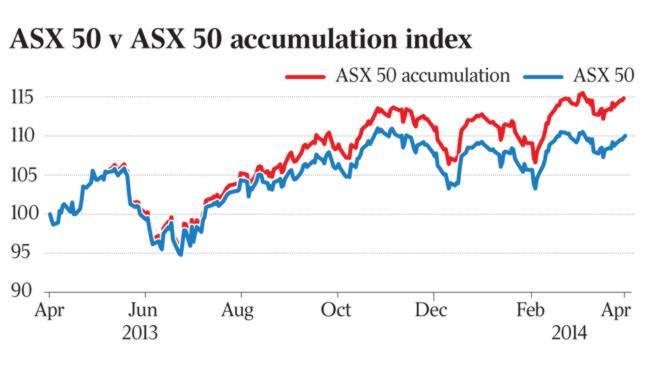High dividends a guide to strength
AS we move towards the middle of 2014 the superior path to investment income remains dividends from shares.

AS we move towards the middle of 2014 the superior path to investment income remains dividends from shares, with average dividend yields at 4.5 per cent.
RP data this week released figures showing rental yields were dropping — to less than 4 per cent gross in Sydney and Melbourne. Meanwhile cash rates at 2.5 per cent have been unchanged for seven months in a row.
As a result the art of drawing dividends from the stockmarket — which stocks you choose, which stocks you keep and, perhaps most importantly, which stocks you reinvest through a dividend reinvestment program — becomes crucial.
In the past year the kings of the dividend regime, our banks, Telstra and leading property trusts, have been joined by a string of wannabe dividend leaders ranging from iron ore player Fortescue to explosives maker Orica. As a result Australia has one of the most generous dividend regimes in the world, with dividends — especially when supercharged by franking credits — running at perhaps twice the rate of the US.
But what are the guidelines for the Australian investor? What can we learn if we examine recent dividend patterns on the ASX?
Considering our market has become a dividend factory there has been remarkably little attention paid to this aspect of investing.
At Eureka Report recently we carried out two different exercises to find out: (a) which stocks are the best in terms of growing dividend — having a high dividend is not, in itself, always a positive sign because the company must be in sufficient shape to maintain that dividend; and (b) we examined the merits of those multi-billion DRP schemes run by our biggest companies that encourage shareholders to directly reinvest their dividends rather than taking the proceeds in cash.
Put simply, the results were dramatic and unambiguous — both dividend growers and top companies that offer consistent DRP programs (ie, unbroken over five years) beat all relevant benchmarks.
The outperformance of dividend growers was perhaps predictable. After all if everyone is hunting strong dividend-paying stocks then the companies that win that race are going to win the stock price growth race.
To put numbers on it, more than 80 per cent of the top 25 dividend growers (those that have increased their dividends each period in the past three years) have beaten the market’s benchmark total return of 31.2 per cent over the past three years.
The dividend grower set includes the big four banks; after that it is a mixed crew with not as many property trusts as you may expect and some surprises including STW Communications, Sky Network Television and Skilled Group.
In a way the process is self-perpetuating. Offer a higher dividend and a company widens its attractions, which empowers the company by pushing up its share price.
The locomotive must never be allowed to drop speed, however, so the company must be seen to continue lifting the dividend. Hence a few weeks ago we saw the already generous payout at the Commonwealth Bank increased again as the bank lifted its half-year dividend to $1.83, beating expectations of $1.81.
It is in DRP strategy that some real insight has been revealed. There have been times in recent years where DRPs have drifted out of fashion. Some companies saw them as inefficient, some investors wondered if they were just “ticking the box” on DRP programs because they couldn’t think of anything better to do with the cheque.
But the evidence is clear — with the best stocks you are measurably better off enlisting in the DRP. Within the ASX Top 50 the 15 companies that have had a DRP operating consistently for 10 years or more also turn out to be index beaters.
How does it work? Well, if you take the relevant 15 companies from the top 50 and you measure their performance, assuming you reinvested your dividends in that group rather than taking the cash and repeating the process through investing in an ASX 50 index, you would outperform by 15 per cent over five years.
If you repeat exercise against the ASX 200, the outperformance comes to 20 per cent — in other words, folks, the compounding effect of reinvesting dividends is not to be sneezed at.
It’s also worth pointing out that when similar exercises were carried out in the US they got very similar results — that is the consistent dividend payers are better to invest in than their lesser yielding rivals.
The US-based Bankrate group earlier this year studied the performance of what is known on Wall Street as the dividend aristocrats. This group of US blue chips has managed to not only pay dividends for each of the past 25 years but also raised them every year. The study found the dividend aristocrats beat balanced portfolios over a range of time periods.
Within the Australian market there are exceptions to the rule, where the dividends have been strong but the companies have not achieved the performance to justify the yield on offer — names include mobile accommodation group Fleetwood and pharmaceuticals operator Nufarm.
Overall then, if you want yield go for shares; if you want extra yield go for dividend growers and, if you want to make it all easier, reinvest in the best of them every time you are given the chance.
James Kirby is managing editor of Eureka Report. This article is part of the Hunt for Yield series in Eureka Report focusing on new opportunities for yield.



